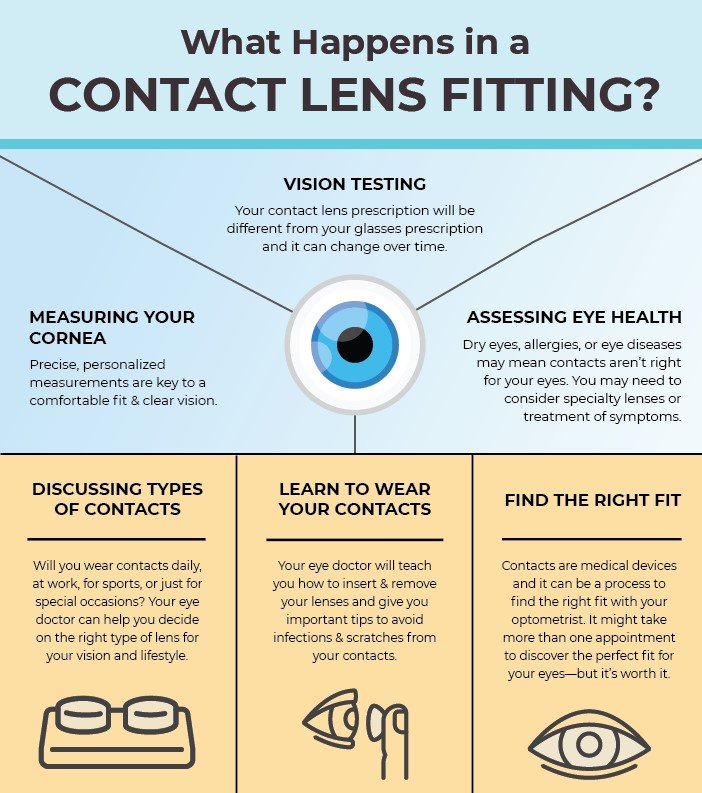
Contact lenses offer a convenient and versatile way to correct vision, providing a wider field of view compared to eyeglasses. However, finding the perfect pair isn’t as simple as picking them off the shelf. A proper fit is crucial for both comfort and eye health. This article will delve into the world of contact lens fittings, exploring when they are necessary, the process involved, and the benefits they offer.
This comprehensive guide will walk you through the key aspects of contact lens fitting, from understanding your individual needs to choosing the right lenses and ensuring proper care. By the end, you’ll have a clear understanding of why a professional fitting is often the best choice for achieving optimal vision and eye health with contact lenses.
Contact Lens Fitting Process
A contact lens fitting typically involves several steps conducted by an optometrist or ophthalmologist.
First, a comprehensive eye exam will be performed to determine your prescription, corneal shape, and overall eye health. This includes measuring the curvature of your cornea, assessing your tear film production, and checking for any underlying eye conditions.
Next, the eye care professional will select several different types and sizes of contact lenses based on your individual needs and preferences. These lenses will be fitted onto your eyes, and you’ll have the opportunity to try them out and provide feedback on comfort, clarity, and vision. Adjustments may be made until a perfect fit is achieved.
Finally, the optometrist or ophthalmologist will provide you with instructions on how to insert, remove, clean, and store your contact lenses safely and effectively. They’ll also schedule follow-up appointments to monitor your progress and ensure your eyes are healthy and comfortable.
When Do You Need a Contact Lens Fitting?
While some individuals may be able to purchase over-the-counter contact lenses for minor vision correction, most people benefit from a professional contact lens fitting.
Do you have to get fitted for contacts? It’s generally recommended to consult an eye care professional for a fitting if:
- You require a prescription for vision correction
- You have any pre-existing eye conditions
- You experience discomfort or irritation with glasses
- You want to explore the benefits of contact lenses for specific activities, such as sports or swimming
- You are unsure about the proper insertion, removal, or care techniques for contact lenses
Benefits of a Professional Contact Lens Fitting
A professional contact lens fitting offers numerous advantages over purchasing contacts without professional guidance.
Firstly, it ensures accurate prescription determination, which is crucial for optimal vision and eye health. An optometrist or ophthalmologist will use specialized equipment to measure your corneal curvature and refractive error, providing a precise prescription tailored to your individual needs.
Secondly, a fitting allows the eye care professional to select the most suitable type and size of contact lenses for your eyes. Different lens materials, designs, and parameters cater to various vision correction needs, eye shapes, and lifestyles. A professional can guide you through the options and recommend the best fit for your comfort and visual acuity.
Finally, a fitting provides valuable education on safe insertion, removal, and care practices. An optometrist or ophthalmologist will demonstrate proper techniques and offer personalized instructions to ensure the health and longevity of your contact lenses and eyes.
Choosing the Right Contact Lenses
With a wide array of contact lens options available, selecting the right pair can seem overwhelming.
Consider these factors when making your decision:
- Prescription: Your eye care professional will provide you with a specific prescription based on your vision needs. Ensure the lenses you choose match this prescription accurately.
- Lens Type: There are various types of contact lenses, including soft, rigid gas permeable (RGP), and hybrid lenses. Each type offers different benefits in terms of comfort, durability, and vision correction. Discuss your lifestyle and preferences with your eye care professional to determine the best option for you.
- Wearing Schedule: Contact lenses come in daily, weekly, or monthly disposables. Choose a schedule that aligns with your needs and budget.
Contact Lens Care and Safety
Proper contact lens care is essential for maintaining eye health and preventing infections.
Follow these guidelines:
- Wash your hands thoroughly before handling your lenses.
- Use fresh solution to clean and disinfect your lenses according to the manufacturer’s instructions.
- Never reuse contact lens solution.
- Replace your lenses as recommended by your eye care professional.
- Remove your lenses before sleeping, unless you have extended-wear lenses prescribed by your doctor.
- Attend regular follow-up appointments with your optometrist or ophthalmologist for checkups and lens adjustments.
Conclusion
A contact lens fitting is an essential step for anyone considering wearing contact lenses. It ensures accurate prescription determination, proper lens selection, and guidance on safe insertion, removal, and care practices. By investing in a professional fitting, you can enjoy the benefits of clear vision, comfort, and overall eye health while minimizing the risk of complications. Remember to consult with an optometrist or ophthalmologist for personalized advice and ongoing care throughout your contact lens journey.
